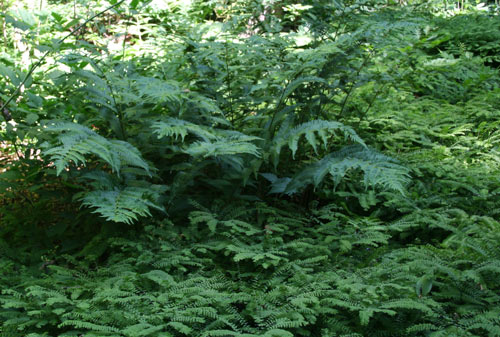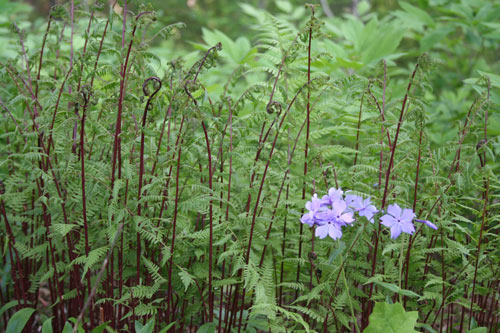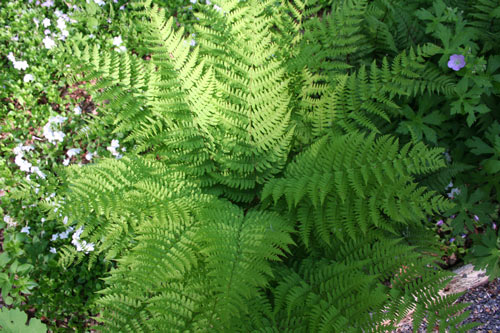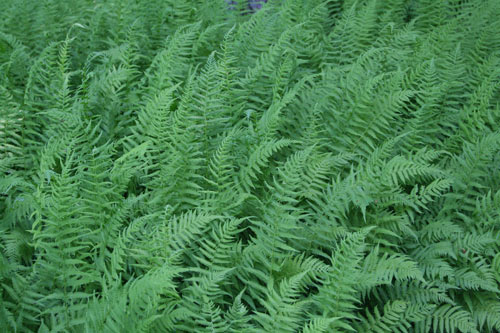By Leslie Duthie, New England Botanic Garden Volunteer
Ferns are often overlooked when we think about gardening, but ferns are great plants that have many functions from use as a background plant, to a specimen, or highlight, from a place to rest your eye, to a thread running through the flowers. While ferns are sometimes thought of as ‘difficult,’ needing special care and special conditions, they are really very tolerant plants that can grow in a wide range of conditions and settings without any more care than our perennials.
Best ferns to use as a background
Ferns can be used as a backdrop to smaller perennials and wildflowers in our gardens, to divide one section from another, or hide things from view. The best ferns for this type of planting grow to three to four feet tall and have deep green color and probably prefer a shaded location tolerating up to a half day of sun or bright light. Many of the wood ferns (Dryopteris spp.) fall into this category. Plants like Goldie’s fern (Dryopteris goldiana), ostrich fern (Matteuccia struthiopteris), and lady fern (Athyrium angustum) each have a beautiful vase shape, spread slowly by a creeping rhizome or underground stem, and form colonies of individual plants in the garden.
- Goldie’s fern (Dryopteris goldiana) has the coarsest texture of these species and lovely arching fronds. It is stately, tall, and tolerant of average soils. It does not need a lot of attention or care and prefers a shadier site.
- Ostrich fern (Matteuccia struthiopteris) is found in river flood plains and is tolerant of wet soils that dry out in summer, but it will thrive in an average to moist garden soil. Ostrich fern has an interesting form with the widest part of the frond near the tip, giving each frond a ‘feather-like’ appearance. It grows in lovely upright clumps. Ostrich fern produces a separate spore structure that remains standing throughout the winter, providing interesting texture and form in the winter garden.
- Lady fern (Athyrium angustum) has a finer texture. Its leaflets are finely toothed and divided giving it a softer feel in the garden. Its form is broadly spreading, and it grows in a wide range of soils. In nature, it’s most often found in deeper woodlands where it tolerates a very wide range of light conditions.
Ferns to spotlight as specimens
Specimen plants provide focal points of interest in the garden. Many ferns available in garden centers, nurseries, and native plant centers make excellent specimens. Even those listed above as background species can be used as a highlight in the garden. A couple of non-native ferns, Autumn fern (Dryopteris erythrosora) and Japanese painted fern (Athyrium niponicum) are two stunning plants that provide color and interest. Autumn fern fronds emerge with a golden-bronze color that turns to green as they mature. Painted fern keeps its silver and red coloration throughout the season and really lights up a shaded garden space. These two species prefer shade and a humus-y soil, rich in organic material. Native ferns that are excellent as specimens include:
- Red-stemmed lady fern (Athyrium angustum ‘Lady in Red’). With its fine texture and striking red stalks, this is an exceptional addition to the shade (or part-shade) garden. It pairs well with white flowers in spring.
- Maidenhair fern (Adiantum pedatum) has outstanding form with its upright, black, wiry stems and short wavy leaflets (pinnae). It spreads slowly by forming larger clumps, and it is easy to divide in spring or fall.
- Marginal wood fern (Dryopteris marginalis) is a great all-purpose fern that has glossy foliage through the summer that persists into early winter. It has very scaley stalks that look like woolly animal feet when the fiddleheads emerge from the soil.
- Christmas fern (Polystichum acrostichoides) is another versatile fern for the garden. It can be used as a specimen or widely planted among otherperennials. Some consider this fern as ‘evergreen’ because its foliage remains green for a full year, providing winter interest in the garden. After the first heavy snow, the foliage tends to flatten, but the lustrous green color remains for the whole season. New fronds arise each spring and the older fronds die away.
All of these ferns thrive in a wide range of soil conditions from dry-ish to moist. Although they do best in shade, they also grow well in part sun locations. A rule of thumb is the more sun, the more moisture needed to keep the plants looking good.
Ferns for naturalizing
Ferns can be great for some of the most difficult places in the yard or garden. Some ferns are tough, aggressive plants that would not be suggested for most gardens, yet they tolerate harsh conditions such as under conifers, beneath a large maple tree, or those places where even grass will not grow. These ferns naturalize an area with their soft foliage and make a tough place look nice.
- Hay scented fern (Dennstaedtia punctilobula) is a rampant long-running fern that grows in both sun and shade and almost any kind of soil. It reaches about 12” to 24” in height and will fill in areas where others dare not grow. It has a lovely golden fall color when growing in sunny locations and its fine texture can soften a rough area.
- New York fern (Parathelypteris noveboracensis) is best under evergreen trees as it is shorter (12”) and tolerates deep shade. It can handle acidic soils and only needs some light to spread under evergreen trees. If a thick layer of pine needles is present, remove some prior to planting so that New York fern can become established. Some light needs to reach the forest floor for this one to survive, but it is definitely another great choice for a difficult spot.
Ferns are wonderful plants, so overlooked, yet like many perennials, they become established and spread over time. They are also relatively easy to transplant, allowing you to move them around the garden to fill in areas as needed. So don’t be fooled into thinking these are tough plants to cultivate —rather they are tough plants that can be easily established in your shaded garden spaces!
*Featured image: Maidenhair fern (Adiantum pedatum)
About the Author
Leslie Duthie worked as a horticulturist growing, planting, and caring for native plants for over 40 years. Now retired, she enjoys all kinds of gardening. Volunteering at NEBG, Leslie cares for its historic apple orchard. She also serves as a board member of the Ecological Landscape Alliance, an organization educating people about ecological gardening practices.




